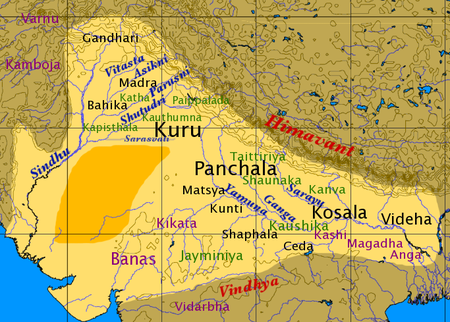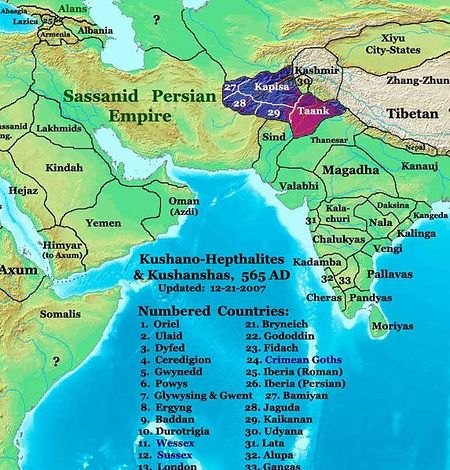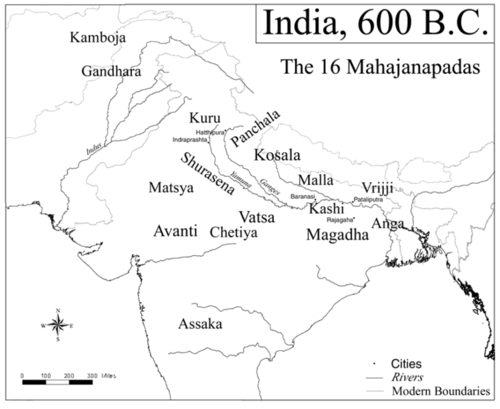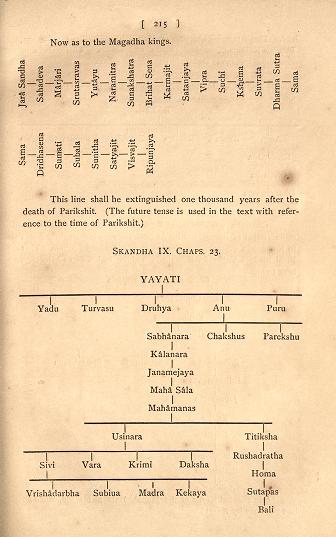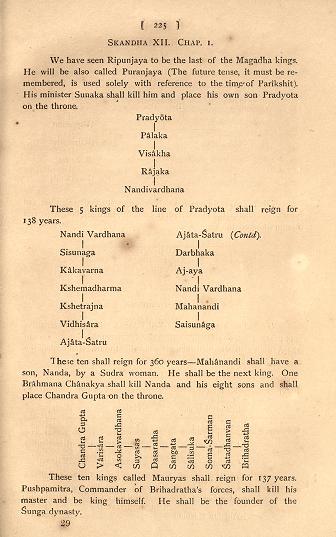
| MAGADH
Map of Vedic Bharat
Map of Vedic Bharat Magadh formed one of the sixteen so-called Mahajanpads (Sanskrit, 'great country') or regions in ancient India. The core of the kingdom was the portion of Bihar lying south of the Ganges, with its capital at Rajagriha (modern Rajgir).
Location
:
Mention by Panini :
Magadh
Man is mentioned by Panini in Ashtadhyayi.
Geography :
Ancient Indian Kingdoms in 600 BC The kingdom of the Magadh roughly corresponded to the modern districts of Patna and Gaya in southern Bihar, and parts of Bengal in the east. It was bounded on the north by river Ganga, on the east by the river Champa, on the south by Vindhya mountains and on the west by river Son. During Buddha’s time and onward, its boundaries included Ang.
History
:
There is little certain information available on the early rulers of Magadh. The most important sources are the Buddhist Chronicles of Sri Lanka, the Purans, and various other Jain and Buddhist texts. Based on these sources, it appears that Magadh was ruled by the Sisunag dynasty for some 200 years, c. 550 BC - 350 BC. The Sisunag dynasty was overthrown by Ugrasen Mahapadma Nand, the first of the so-called nine Nands (a.k.a. the Nand or Nav Nand dynasty). He was followed by his eight sons, whose names were (according to the Mahabodhivams) Panduk, Pandugati, Bhutpal, Ratthpal, Govisanak, Dasasiddhak, Kevatt, and Dhan Nand. According to the Sri Lankan Chronicles, the Nand dynasty was in power for mere 22 years, while the Puranas state that Mahapadma ruled for 28 years and his eight sons for only 12.
King Bimbisar of the Hariyank dynasty led an active and expansive policy, conquering Ang in what is now West Bengal.
Siddharth Gautam himself was born a prince of Kapilavastu in Kosal around 563 BC. As the scene of many incidents in his life, Magadh was a holy land.
After the death of Bimbisar at the hands of his son, Ajatashatru, the widowed princess of Kosal also died of grief, causing King Prasenajit to revoke the gift of Kashi and triggering a war between Kosal and Magadh. Ajatashatru was trapped by an ambush and captured with his army; but in a peace treaty he, his army, and Kashi were restored to Magadh, and he married Prasenajit's daughter.
Accounts differ slightly as to the cause of Ajatashatru's war with the Licchavi republic. It appears that Ajatashatru sent a minister, who for three years worked to undermine the unity of the Licchavis at Vaishali. To launch his attack across the Ganga River, Ajatashatru had to build a fort at a new capital called Pataliputra, which the Buddh prophesied would become a great center of commerce. Torn by disagreements the Licchavis were easily defeated once the fort was constructed. Jain texts tell how Ajatashatru used two new weapons – a catapult and a covered chariot with swinging mace that has been compared to modern tanks.
In
326 BC, the army of Alexander the Great approached the boundaries
of the Magadhn Empire. The army, exhausted and frightened by the
prospect of facing another giant Indian army at the Ganges River,
mutinied at the Beas River (Hyphasis) and refused to march further
East. Alexander, after the meeting with his officer, Coenus, was
convinced that it was better to return, and turned south, conquering
his way down the Indus to the Ocean.
In
Mahabharat :
Kings of Magadh :
Ancestry of Magadh Kings
Brihadratha Dynasty (c. 1700–799 BC) :
•
Susharma Chand
Pradyota ancestry :
Pradyot ancestry Ruling 799-684 BC according to calculations based on the Vayu Puran.
•
Pradyot
Gupta
Dynasty (c. 240-550 AD) :
[p.453]: seventh century, therefore, we may readily admit that the old city, of Kusumapur may have been about half this size, or 11 miles in circuit, as stated by Hwen Thsang.
Diodorus attributes the foundation of the city to Herakles, by whom he may perhaps mean Balram, the brother of Krishna, but this early origin is not countenanced by the native authorities. According to the Vayu Puran the city of Kusumapur or Pataliputra was founded by Raja Udayaswa, the grandson of Ajatasatru, who was the well-known contemporary of Buddh ; but the ' Mahawanso' makes Uddaya the son of Ajatasatru. According to the Buddhist accounts, when Buddh crossed the Ganges, on his last journey from Rajagrih to Vaisali, the two ministers of Ajatasatru, king of Magadh, were engaged in building a fort at the village of Patali as a check upon the Wajjians, or people of Vriji. Buddha then predicted that it would become a great city. From these concurring authorities I conclude that the building of the city of Pataliputra was actually begun in the reign of Ajatasatru, but was not finished until the reign of his son, or grandson, Udaya, about B.C. 450.
The position of the city at the junction of the Ganges and Erannoboas was formerly supposed to refer to the confluence of the Gandak or Hiranyavati, which joins the Ganges immediately opposite Patna. But it has been conclusively shown by Mr. Eavenshaw that the Son river formerly joined the Ganges
[p.454]: just above the city of Patna. As the Sona, or "golden" river, is also called the Hiranya-bah, ox the golden, on account of its broad yellow sands, its identification with the Erannoboas is complete both as to name and position.
Strabo and Pliny agree with Arrian in calling the people of Palibothra by the name of Prasii, which modern writers have unanimously referred to the Sanskrit prachya, or "eastern". But it seems to me that Prasii is only the Greek form of Palasiya or Parasiya, a "man of Palasa or Parasa," which is an actual and well-known name of Magadh, of which Palibothra was the capital. It obtained this name from the Palasa, or Butea frondosa, which still grows as luxuriantly in the province as in the time of Hwen Thsang. The common form of the name is Paras, or when quickly pronounced Pras, which I take to be the true original of the Greek Prasii. This derivation is supported by the spelling of the name given by Curtius, who calls the people Pharrasii, which is an almost exact transcript of the Indian name Parasiya. The Praxiakos of Aelian is only the derivative form Palasak.
According to Hwen Thsang's estimate the province of Magadh was about 5000 li, or 833 miles, in circuit. It was bounded by the Ganges on the north, by the district of Banaras on the west, by Hiranya Parvat, or Mongir, on the east, and by Kirana Suvarna, or Singbhum on the south. It must, therefore, have extended to the
[p.455]: Karmnasa river on the west, and to the sources of the Damuda river on the south. The circuit of these limits is 700 miles measured direct on the map, or about 800 miles by road-distance.
As Magadh was the scene of Buddh's early career as a religious reformer, it possesses a greater number of holy places connected with Buddhism than any other province of India. The chief places are. Baudh-Gaya, Kukhutapad, Rajagrih, Kusagarapur, Nalanda, Indrasilaguh, and the Kapotik monastery, all of which will be described separately, whilst the smaller places will be noticed in the account of Hwen Thsang's route to the more important localities.
Jat
Gotras associated with Magadh :
The Geographike of Ptolemy says that in 140 AD, the Murundas were established in the valley of the river Sarabos or Sarayu. Half a century later, Oppien mentions the "Muruandien" as a Gangetic people. S R Goyal quotes several other Jain authorities to show that Patliputra in particular, as well as Kanyakubj were ruled by Murundas/Sakas. The Jain ascetic, Padlipta Suri, cured the Murunda ruler of Patliputra of terrible headache and converted him to Jainism. During the reign of Wu dynasty (220 - 227 AD) Fan Chen, the King of Kambodia, according to PC Bagchi sent his relative as ambassdor to the Indian King of Patliputra. The ambassador was heartily welcomed and the gesture was returned by the Indian king who sent two men as ambassador as well as four horses of the Yue-chi i.e. the Jat country, as presents to the King of Kambodia. According to this account Buddhism was in prosperous state at that time in Magadh and the title of the king was Meouloun. This title has been identified with Murunda and this shows that in the middle of third century AD the Murundas were still ruling over Patliputra. These Murunda rulers of Patliputra had special relations with Peshawar. It was but natural, for, after all Murundas and Kushans both belonged to the same Scithian stock.
From this it is clear that racially the rulers of Magadh in the third century AD were identical with Kushans, ruling Afghanistan. In the Purans they are mentioned as ruling India after the Tukhars (Takhar Jats) and Purans also say that 13 kings of Murunda dynasty ruled India. It is significant that the Purans also mention that these Murunda rulers destroyed the caste system and, in the language of Purans, they raised "low caste people" to high offices and all these people were of "Malech" origin. The Vishnu Puran correctly gives the clan name of these people as Munda - a still existing Jat clan. The title Murunda means "Lord", in Saka language, as per Sten Konow.
Thus the literary evidence and evidence of Purans shows that immediately before the Guptas, the Mundas were ruling over Magadh and their rule lasted for about two centuries, by taking 15 years for one rule. It is unfortunate that none of the thirteen rulers, is even named in the Indian history. This is really a pity for the Indian historians. Apparently, all this was deliberately done to remove all traces of the rule of the Jats which lasted for many centuries in all parts of India. It is possible that the Purans, which were revised during or after the Gupta age, deliberately excluded details of these Jat rulers.
Thus inscriptional as well as the literary and Puranic evidence shows that various Jat clans ruling in North India. The Varikas, the Mauryas, the Mundas, the Kushanas, the Taanks, etc. are of them. Various other clans having republic governments, mentioned in the Allahabad Pillar inscription of Samudragupta, are still existing Jat clans. This clear picture of different Jat clans ruling in different parts of north India is striking and can not be ignored by any writer of Indian history.
Manghat
:
Kasya
:
Mangadh
:
Burdak
:
The Burdak gotra of Jats are probably related with Virudhaka also. Virudhaka was son of Raja Prasenjit and king of Kashi. Soon after usurping the prosperous kingdom built up by his father Bimbisar, the parricide Ajatashatru went to war with his aged uncle Prasenjit, and gained complete control of Kashi. Just after this Prasenjit, like Bimbisar, was deposed by his son Virudhak, and died. The new king, Virudhak, then attacked and virtually annihilated the little autonomous tribe of Shakyas, in Himalyan foothills, and we hear no more of the people which produced the greatest of Indians, the Buddha. Probably Virudhak, like Ajatashatru of Magadh, had ambitions of empire, and wished to embark on a career of conquest after bringing the outlying peoples, who had paid loose homage to his father, more directly under the control of the centre; but his intentions were unfulfilled, for we hear no more of him except an unreliable legend that he was destroyed by a miracle soon after his massacre of Shakyas. A little later his kingdom was incorporated in Magadh. Alexander Cunningham found a sculpture of Virudhaka at Bharhut stupa in Satna district in Madhya Pradesh. There is an inscription in a scene at Bharhut which reads as under :
Vadukokath
dohati nadode pavate - This long label inscription shows a curious
scene but could not be made out by historians. Infact Vaduko has
been used for Burdak in prakrit language.
Podoth
:
•
Lamboria, Chavel, Talan, Chakora
Trigart (Trigart Raj) Dynasty (BC unknown) :
•
Katoch Clan Kings & Emperors
Source :
https://www.jatland.com/ |
